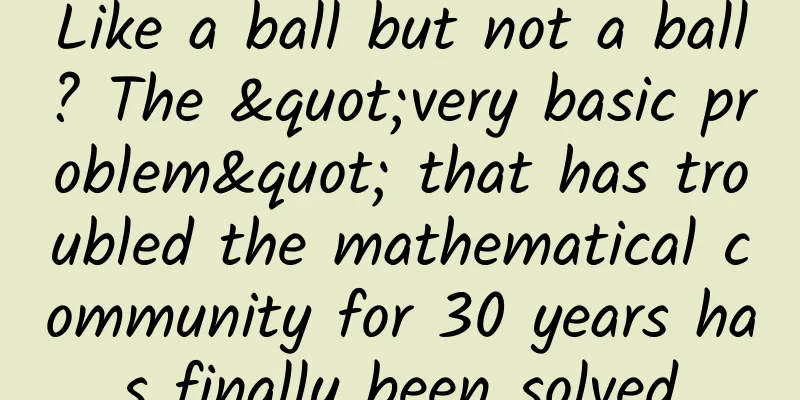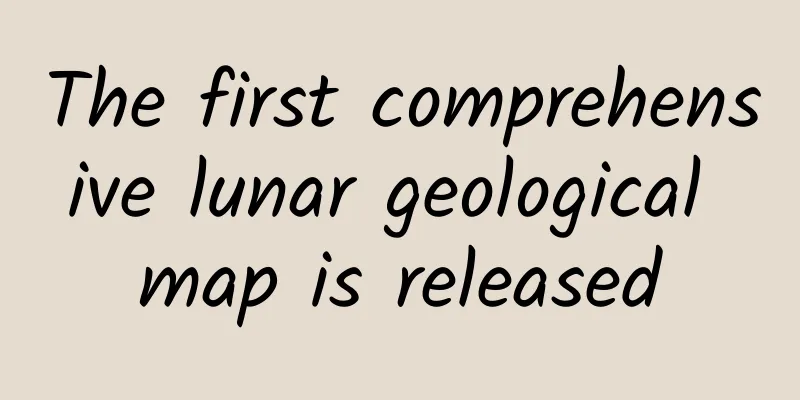Like a ball but not a ball? The "very basic problem" that has troubled the mathematical community for 30 years has finally been solved

|
Five mathematicians have not only solved a difficult problem in high-dimensional geometry, but have also given the mathematical community its first glimpse into what these mysterious high-dimensional geometric objects might look like. Although these shapes are easy to define, they are surprisingly mysterious. Now, researchers can finally access a corner of the geometric universe that was once completely inaccessible. Written by | Jiawei I don't know if you have ever seen a bicycle with triangular wheels. Yes, it is quite stable to ride without any bumps. Engineer Sergii Gordieiev invented the triangular wheel bicycle Put a circle between two parallel lines and make it tangent to the two parallel lines. Then no matter how we rotate the circle, the distance between the two parallel lines will remain the same. We call this property the constant width property. However, the circle is not the only constant-width curve on the plane. If the three vertices of an equilateral triangle are used as the center of the circle and the length of the side is used as the radius, then the figure formed by the three arcs that wrap around the equilateral triangle is a non-circular constant-width curve. In fact, it is the simplest and most famous constant-width curve besides the circle: the Reuleaux triangle. Constructing a Reuleaux triangle Because its width is constant, the Reuleaux triangle is an answer to the question "What other shapes can you make manhole covers in addition to circles?" Interested friends can try to verify its constant width property. The tire of the bicycle in the above animation is in the shape of a Reuleaux triangle. The constant width allows the bicycle to run smoothly, but due to practical reasons in engineering and mechanics, Reuleaux triangle tires are currently not practical. However, this does not mean that the Reuleaux triangle can only serve as a gimmick in short videos - we will introduce its various industrial applications later - it is also an important research object in mathematics. But the most embarrassing thing is that the more thoroughly we study the Reuleaux triangle and other constant-width curves in history, the more we discover how little we know about constant-width geometry in three-dimensional and higher-dimensional Euclidean space. Gil Kalai, professor emeritus of mathematics at the Hebrew University of Jerusalem, is one of the leaders in the field of contemporary combinatorics. More than a decade ago, he commented on the mathematics community MathOverflow: "Constant-width sets (except balls) were not fortunate enough to be chosen as the norm of Banach space, and could not attract experts in the powerful Banach space theory to study their asymptotic properties in large dimensions." Therefore, the mathematics community has put the study of fixed-width geometry in high-dimensional space into the cold palace. But then he changed his tone: "...but they (high-dimensional fixed-width geometries) are very exciting, and this seems to be a very fundamental problem." The "very basic question" here refers specifically to a seemingly simple question raised by Oded Schramm (a former student of Professor Kalai) while studying for his doctorate at Princeton University in 1988: Can we construct a fixed-width geometric body in any dimension that is exponentially smaller than a sphere? This very basic question has puzzled the mathematical community for more than 30 years. Until May this year, five researchers reported that the answer is yes. Not only have they solved a difficult problem in high-dimensional geometry, they've also given the mathematical community its first glimpse into what these mysterious high-dimensional geometric objects might look like. While these shapes are easy to define, they're surprisingly mysterious. Now, researchers can finally access a corner of the geometric universe that was once completely inaccessible. From 2D to 3D and beyond The way to define a fixed-width geometric object in three-dimensional space (hereinafter referred to as a fixed-width body) is similar to the way to define a fixed-width curve. The only difference is that the curve is sandwiched between two parallel lines, while the solid object is sandwiched between two parallel planes. If the distance between parallel planes does not change no matter how the solid object moves, then we call it a three-dimensional fixed-width body. Similarly, we can define a fixed-width body in general n-dimensional space, except that we need to replace the plane with an n-1-dimensional hyperplane. The sphere in three-dimensional space and the n-dimensional unit ball with a radius of 1 in n-dimensional space (denoted as Bn) are the most easily thought of constant-width bodies. However, is the sphere the only type of constant-width body? Mathematicians in history also wanted to figure out this problem. They imitated the way of constructing Reuleaux triangles and constructed Reuleaux tetrahedron in three-dimensional space. The idea is to construct four spherical shells with the vertices of the regular tetrahedron as the center and the side length as the radius. The space enclosed by the sphere divided by the four spherical shells is the Reuleaux tetrahedron. At first, people speculated that the Reuleaux tetrahedron was a non-spherical fixed-width solid in three-dimensional space. Unfortunately, it is not. You can try to calculate and verify this. Reuleaux tetrahedron The good news is that it can be transformed into a fixed-width body through local "surgery"! So now we have the first non-spherical three-dimensional fixed-width body - the Meissner body. I believe readers have also noticed that it is not easy to construct a constant-width body in three-dimensional space, and it is even more difficult to construct a constant-width body in higher-dimensional space. Moreover, in order to solve the problem raised by Schramm, it is also necessary to ensure that: For a positive number q less than 1, when n is large enough, there always exists an n-dimensional fixed wide body Kn with a width of 2, whose volume V(Kn) < q^n·V(Bn). Where V(*) represents the volume of the object*. Mathematicians can't figure out how to directly construct a high-dimensional constant-width body, so they can only rely on existing experience. Following the successful paths in two and three dimensions, start with a set of points (called "seeds"), and then make a high-dimensional sphere with each seed as the center. Look for an object that can be wrapped by all the spheres to see if it has a constant width. But in a high-dimensional world, figuring out what shapes a subset of seeds can lead to is a very difficult task. Four Ukrainian mathematicians, Andrii Arman, Andriy Bondarenko, Danylo Radchenko and Andriy Primak, experimented with different seeds and eventually found a specific surface. They knew that the surface delimited a region that contained a sufficiently small fixed-width body. But they wanted to know what the fixed-width body looked like. As they searched for answers, Arman came across a 2022 post on MathOverflow that led to the acquaintance of Fedor Nazarov at Kent State University. He had been working independently on Schramm’s problem, and his approach looked very similar to that of the Ukrainian team, though he, too, was stuck. The Ukrainian team invited him to join them. That’s when Nazarov realized something that the others had missed: the shape given by their seed didn’t simply contain a fixed-width body, it was the fixed-width body! From left to right: Andrii Arman, Andriy Bondarenko and Danylo Radchenko, Fedor Nazarov, and Andriy Primak. | Source: Andrii Arman, Andriy Bondarenko, Fedor Nazarov, Andriy Prymak, and Danylo Radchenko Constructed Small Volume Bodies of Constant Width | Combinatorics and more (wordpress.com) In that eureka moment, all the problems fell into place. Their work showed that for any sufficiently large dimension n, there exists a fixed-width body Kn of width 2 such that V(Kn) < 0.9^n·V(Bn). Arman said that although the conclusions were based on complex ideas, their construction was easy for undergraduates to verify. In fact, their paper was only seven pages long (see reference [6]), and did not provide any 3D diagrams of the constructed geometric bodies. In a geometry paper, the absence of diagrams of geometric objects even caused complaints from many mathematicians. Keenan Crane, a digital geometer and associate professor of computer science and robotics at Carnegie Mellon University, created an image of a three-dimensional fixed wide body according to the method in the paper, and specifically pointed out that because the original paper did not have an accompanying picture, he made one himself. A fixed-width body in 3D space that is smaller than a sphere. Image source: Keenan Crane, digital geometer and associate professor of computer science and robotics at Carnegie Mellon University Back to 2D Although the work of Arman et al. has revealed the asymptotic properties of constant-width bodies in general n-dimensional space, it is still at the "skin-and-skin" stage. Compared with two-dimensional constant-width curves, we still know very little about the details of high-dimensional constant-width bodies. In addition to the Reuleaux triangle introduced earlier, there are a large number of constant-width curves. In fact, we can mathematically prove that every regular polygon with an odd number of sides can generate a constant-width curve by drawing a circular arc. Such constant-width curves are called Reuleaux polygons. The Reuleaux triangle is the simplest Reuleaux polygon. However, the edges of Reuleaux polygons are all arcs. Is there a constant-width curve whose edges are not arcs? The answer is yes. We have non-circular arcs, smoother algebraic curves of constant width. For example, the zeros of the following polynomial form a non-circular smooth algebraic curve of constant width: The degree of the curve is 8, which is the smallest possible degree for a polynomial defining a non-circular curve of constant width. For all constant-width curves, Barbier's theorem holds: the perimeter of a constant-width curve is πw (where w is the constant width), regardless of its shape. In addition, the very important Blaschke-Lebesgue theorem states that the Reuleaux triangle has the smallest area among all constant-width curves of the same width. Many mathematicians have tried to find the smallest constant-width body in three dimensions, but to no avail. Arman's five-member team has been working on the above problem in recent months after solving Schramm's problem, but recently announced that they gave up the pursuit and returned to their earlier research work because they had no results. History and Applications of the Reuleaux Triangle We live in a three-dimensional world after all, and cutting-edge research in high-dimensional geometry often has limited impact on real life. According to Arman, in higher dimensions, the fixed-width bodies they discovered may help develop machine learning methods for analyzing high-dimensional data sets. But the Reuleaux triangle has certainly been used in a variety of life and industry scenarios. Franz Reuleaux, a German engineer in the 19th century, was a pioneer in the study of machines that convert one motion into another. He used the Reuleaux triangle in his design. That's how it got its name. But its history goes back much further. An early application of the Reuleaux triangle came from a world map drawn by Leonardo da Vinci around 1514, in which the spherical surface of the earth was divided into eight pieces, each of which was pressed into the shape of a Reuleaux triangle. World map drawn by Leonardo da Vinci around 1514 | Source: Reuleaux triangle - Wikipedia However, the first person to realize the existence of constant-width curves and to observe that the Reuleaux triangle has constant-width properties was probably Leonhard Euler. In his paper De curvis triangularibus, published in 1771 and republished in 1781, Euler studied curvilinear triangles and what he called quasi-circular curves of constant width. The existence of Reuleaux's triangle and other constant-width curves shows that diameter measurements alone cannot verify whether an object has a circular cross-section. When the Challenger space shuttle exploded 73 seconds into its flight in 1986, renowned physicist Richard Feynman was called in to investigate. He later proved that the "O-ring" seals that were supposed to connect the shuttle's solid rocket booster sections had failed catastrophically due to low temperatures. But he also found a number of other problems. One of them was the way NASA measured the shape of the O-rings. During pre-flight testing, engineers repeatedly measured the width of the seals to verify that they had not deformed. Feynman later wrote that these measurements were useless because of the existence of constant-width curves. Although they present a hazard to the measurement of circular cross-sections, the shape of constant-width curves also presents very useful properties. Several types of machinery currently use the shape of the Reuleaux triangle, based on its ability to rotate within a square. The Reuleaux triangle rolls within a square while always touching all four sides. The Watts Brothers Tool Works square drill bit has the shape of a Reuleaux triangle that is concavely modified to create the cutting surface. It drills a nearly square hole when mounted in a special chuck that allows the drill to have no fixed center of rotation. German engineer Felix Wankel used the Reuleaux triangle to design an internal combustion engine that used eccentric rotation to convert pressure into rotational motion. Stroke cycle of the Wankel KKM engine About 50 years ago, Mazda engineers successfully commercialized Wankel's rotary engine. The rotary engine is known for being smaller and lighter than conventional piston engines and having a superior power-to-weight ratio. Unlike conventional engines, the rotary engine has no reciprocating parts. It uses a triangular rotor that rotates within a housing, making it quieter and smoother to run. This design also allows for excellent performance for a given displacement. Although the last model to use the 13B rotary engine, the RX-8, was discontinued in 2012, Mazda continues to produce rotary engines and their components, maintaining the rotary engine tradition. The film advance mechanism in the Soviet Luch-2 8mm film projector based on the Reuleaux triangle. 丨Source: Reuleaux triangle - Wikipedia Other applications of the Reuleaux triangle include guitar picks, fire hydrant tamper-proof nuts, pencil-shaped designs, and more. The end of the beginning As mentioned earlier, after solving the Schramm problem, the five-member team moved on to other areas of discrete geometry. But they left a new high-dimensional geometric world for others to explore. In 2008, Schramm, who made significant advances in many different areas of mathematics, died in a hiking accident. As his former teacher, Kalai is pleased to see today's researchers carrying on Schramm's legacy and making it a fruitful achievement. Previously, he said, in higher dimensions, people had thought that fixed-width bodies should behave like spheres, at least in terms of their volume properties. But "that's not the case. So that means there's a very rich theory of higher-dimensional geometry." In 2010, Gil Kalai posted on MathOverflow, hoping to attract more mathematicians to pay attention to that "very basic problem" - the Schramm problem. On the last day of May this year, Kalai replied to this long-forgotten post: "The problem has been solved." Acknowledgements: We would like to thank Professor Yi Ni of the Department of Mathematics at California Institute of Technology for reviewing and revising this paper. References [1] Curve of constant width - Wikipedia [2] Reuleaux triangle - Wikipedia [3] mg.metric geometry - Volumes of sets of constant width in high dimnsions - MathOverflow [4] Mathematicians Discover New Shapes to Solve Decades-Old Geometry Problem | Quanta Magazine [5] Andrii Arman, Andriy Bondarenko, Fedor Nazarov, Andriy Prymak, and Danylo Radchenko Constructed Small Volume Bodies of Constant Width | Combinatorics and more (wordpress.com) [6] [2405.18501] Small volume bodies of constant width (arxiv.org) [7] Wankel engine - Wikipedia Special Tips 1. Go to the "Featured Column" at the bottom of the menu of the "Fanpu" WeChat public account to read a series of popular science articles on different topics. 2. Fanpu provides a function to search articles by month. Follow the official account and reply with the four-digit year + month, such as "1903", to get the article index for March 2019, and so on. Copyright statement: Personal forwarding is welcome. Any form of media or organization is not allowed to reprint or excerpt without authorization. For reprint authorization, please contact the backstage of the "Fanpu" WeChat public account. |
<<: Can heating food wrapped in plastic wrap cause cancer? Experts respond
>>: There is no way to catch them all! Why are power plants so afraid of "jellyfish infestations"?
Recommend
Moto X 3rd generation high-end version review: balanced and cost-effective flagship
Motorola Mobility, a subsidiary of Lenovo, today ...
Father’s Day copy is here, it’s from the heart, not the body! !
Father's Day is coming. They are good at many...
What is the difference between hair dye that costs dozens of dollars and hundreds of dollars?
When dyeing their hair, many people often look fo...
How to build a user operation system?
Whether it is offline training or online classes,...
Link Motion Announces Strategic Investment from China AI Capital Limited and Board Adjustment
Beijing, July 19, 2018 – Link Mobility Ltd. (NYSE...
Private Domain Traffic Collection System Course (Friends Circle + Community + Traffic Layout Marketing) 12 lessons completed
If you want to continue to get the old results, c...
Tik Tok live streaming skills for the jewelry industry
"Jewelry is silent, but it can move women mo...
Deconstructing the routines of Xiaohongshu’s popular articles!
This article mainly focuses on the creation and a...
When this type of cancer is discovered, it is usually already in the late stage! In fact, your body has already given you a warning...
Expert of this article: Wang Qian, attending phys...
Taking a different approach and creating a sci-fi-level chariot, is Iron Man going to change his career to work in the military industry?
Rich people are willful, this is a popular online...
German quality, reciprocating double blade heads, Xiaomi Braun electric shaver redefines men's charm
Someone once said that Mijia's products never...
5G mobile phone sales account for more than 70%, but few people use 5G mobile phones. What is the problem?
Up to now, almost no manufacturers have launched ...
Sony Z2 full review
The first obvious change is probably the intuitive...
What is the reason for the sudden change from drought to flood in Henan? Why are there so many floods this year?
Produced by: Science Popularization China Author:...
Touch Technology helps the completion of the "Xiamen Game Innovation Center Project"
On May 15, 2015, the Jimei District Government of...









